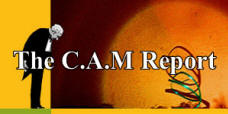|
Visit my blog:

Complementary and Alternative
Medicine: Fair and Balanced |
| |
Prostate cancer patients explore use of CAM
Why not use cancer as a
metaphor and a reason to change all those things in your life that you
wanted to change anyway?
By John Russo, Jr./Vicus.com
|
|
Interest in complementary and alternative medicine (CAM)
has exploded in the 1990s. In 1993, The New England Journal
of Medicine reported that one in three adult Americans used some
form of alternative medicine, most without informing their primary
care allopathic physicians. Americans spent $13.7 billion on 425
million visits to alternative practitioners, compared with $12.8
billion on 385 million visits to primary care allopathic physicians.
A follow-up study published in the November 1998 Journal of the
American Medical Association showed an even more dramatic increase
in CAM visits and expenditures: 629 million visits and $27 billion in
extrapolated annual expenditures.
Now, a report from the 1999 annual meeting of the American Society
of Clinical Oncology (ASCO) suggests that among men with prostate
cancer, the use of CAM may be as high as 80%.
Sixty outpatients receiving care at the Herbert Irving
Comprehensive Cancer Center of Columbia University in New York were
surveyed about their health beliefs and CAM use since their diagnosis
of prostate cancer. Among 48 patients (80%) who reported having tried
at least one CAM modality since being diagnosed, 35 of these men had
tried more than one form of CAM. Nutritional supplementation was most
commonly used (35 patients), followed by dietary modification (25),
herbal treatments (12) and meditation (12).
The number of men included in this survey was small, and it was not
possible to predict who was most likely to try CAM. However, another
recent report in a larger population of 200 patients with head and
neck cancer found an increase in the use of alternative medicine among
patients of younger age, with a postsecondary education, higher
personal income and Indo-Asian extraction.
Commentary
In the book Grace and Grit, by Ken Wilber, the author and
his wife, who had been diagnosed with breast cancer, discuss to what
extent a person with cancer needs to change to get better. He states
that from all the evidence he has seen, cancer appears to be about 30%
genetic, 55% environmental (i.e., drinking, smoking, dietary fat,
toxins, sunlight, electromagnetic radiation, etc.), and 15% everything
else -- emotional, mental, existential, spiritual. However, that means
that at least 85% of the causes may be physical, according to Wilber's
impressions.
As the health of the person living with cancer is directly affected
by lifestyle choices, it is important that the health-conscious
patient attempt to do everything possible to treat their body well.
They need to boost their immune system through the use of nutritious
foods and supplements and eliminate unhealthy habits from their life.
Since nobody knows what causes cancer, nobody knows what to change
to help cure it. So, Wilber suggests, why not use cancer as a metaphor
and a spur to change all those things in your life that you wanted to
change anyway?
John Russo, Jr., PharmD, is senior vice president of medical
communications at Vicus.com. He is a pharmacist and medical writer
with more than 20 years of experience in medical education.
References:
Eisenberg DM et al. Trends in Alternative Medicine Use in
the United States, 1990-1997. JAMA. 1998; 280:1569-1575.
Jacobson JS, Grann VR, Neugut AL et al. Use of
Complementary/Alternative Medicine Among Prostate Cancer Patients.
American Society of Clinical Oncology, Abstract 1228, 1999.
Supporting a person with cancer through illness and death.
Social Inventions Journal. 1993.
http://www.globalideasbank.org/1993/1993-206.HTML
Warrick PD, Irish JC, Morningstar M, Gilbert R, Brown D, Gullane P.
Use of Alternative Medicine Among Patients With Head and Neck Cancer.
Arch Otolaryngol Head Neck Surg. 1999;125:573-9.
Wilber K. Grace and Grit - Spirituality and Healing in the Life
and Death of Treya Killam Wilber. Boston (MA): Shambhala; 1991.
|
|